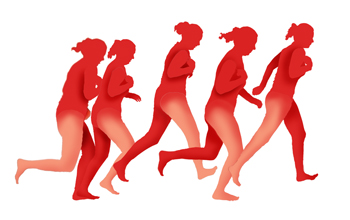|

Press Release 05-161
The Mechanics of Foot Travel

With so many silly gaits to choose from, why have we adopted so few?
September 15, 2005
Despite having the bones and muscles to perform a variety of gaits, human beings have developed an overwhelming preference for just two: walking and running. Now, computer analysis that allows simulation of infinite two-legged locomotions has shown our favored modes of bi-pedal travel use the least amount of energy.
Indeed, in an article published in the current online edition of the British journal Nature, Cornell engineers Andy Ruina and Manoj Srinivasan compare the mechanics of walking and running with "many other strange and unpractised gaits." They used a set of computer models that simulated physical measurements such as leg length, force, body velocity and trajectory, forward speed and work.
"We wish to find how a person can get from one place to another with the least muscle work," they report. "Why do people not walk or even run with a smooth level gait, like a waiter holding two cups brim-full of boiling coffee?"
The engineers' computer simulations conclude that walking is simply most energy efficient for travel at low speeds, and running is best at higher speeds. And, they report, a third walk-run gait is optimal for intermediate speeds, even though humans do not appear to take advantage of it.
The findings help to explain why the possible--but preposterous--gaits in the Monty Python sketch, "Ministry of the Silly Walks," have never caught on in human locomotion. The researchers add that extensions of this work might improve the design of prosthetic devices and energy-efficient bipedal robots.
-NSF-

Media Contacts
Leslie Fink, NSF (703) 292-5395 lfink@nsf.gov
Program Contacts
Leon Esterowitz, NSF lesterow@nsf.gov
Principal Investigators
Andy Ruina, Cornell University ruina@cornell.edu
Manoj Srinivasan, Cornell University ms285@cornell.edu

The National Science Foundation (NSF) is an independent federal agency that
supports fundamental research and education across all fields of science and
engineering, with an annual budget of $6.06 billion. NSF funds reach all 50
states through grants to over 1,900 universities and institutions. Each year,
NSF receives about 45,000 competitive requests for funding, and makes over
11,500 new funding awards. NSF also awards over $400 million in
professional and service contracts yearly.
 Get News Updates by Email Get News Updates by Email
Useful NSF Web Sites:
NSF Home Page: http://www.nsf.gov
NSF News: http://www.nsf.gov/news/
For the News Media: http://www.nsf.gov/news/newsroom.jsp
Science and Engineering Statistics: http://www.nsf.gov/statistics/
Awards Searches: http://www.nsf.gov/awardsearch/
| 

